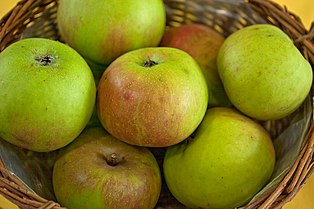Golden Renette from Blenheim
| Golden Renette from Blenheim | |
|---|---|
| Synonyms | Blenheim Orange, Woodstock Pippin |

|
|
| Art | Cultivated apple ( Malus domestica ) |
| origin | Woodstock (Oxfordshire) |
| breeder | Kemster (Finder) |
| Breeding year | around 1740 |
| Launch | 1820 |
| ancestry | |
| List of apple varieties | |
The Golden Renette from Blenheim is a variety of the apple ( Malus domestica ). It was a chance seedling in 1740 from Kemster in Woodstock near Blenheim Palace found.
description
fruit
The large to very large, flat-spherical fruit is 75 mm wide and 60 mm high and weighs 165 grams. The smooth, dry, velvety firm to crumbly skin is colored yellow-green to reddish-yellow and marbled on the sunny side to 30% to 50% cloudy yellow-red to cloudy reddish purple. The fruit is not very sensitive to pressure and is therefore suitable for transport. The medium-firm, yellowish white pulp is fine-celled and juicy. The taste is harmoniously sweet and mildly sour. The stem is short to medium long and thick.
The ripe for consumption is from November to January in which the pulp is rapidly crumbling. It is suitable for cooking from September. The apple is suitable for fresh consumption and domestic processing. When cooking, it retains a comparatively large amount of structure.
tree
The tree is very fast-growing, especially when young, and forms a densely branched, large and broadly flat-spherical crown with almost flat side branches. The leaves are large and uneven.
The flowering period is medium. The tree is ready for harvest between the end of September and mid-October, depending on the climate. The tree bears late and often only in relatively small quantities.
Cultivation
The tree requires sunny locations with nutrient-rich soils and good ventilation in the soil. If the soil is too dry or too moist, the tree has little yield, and if the humidity is high, it is also prone to fruit tree cancer . The tree is triploid , making it a bad pollen donor. It is susceptible to wind and is highly susceptible to speck , flesh tan , wilt, black rot, cancer, blood lice and apple leaf mosaic virus. He is less sensitive to scabs .
Various mutants of the Blenheim were also grown in England in particular. These usually have a more pronounced red color than the trunk form. Common mutants are Aldenheim Blenheim, Red Blenheim and Scarlet Blenheim.
history
The variety was found by a Mr. Kemster around 1740 in Woodstock, Oxfordshire near Blenheim Palace . Initially planted only locally, it became known as Kemster's Pippin during this period , in 1818 it entered the wider market and in 1822 received the Banksia Medal of the Horticultural Society ,
While the Blenheim used to be a valued and widespread variety, today it is only found sporadically. It was grown mainly for its taste and is considered the possible father of Cox Orange and parent variety of Biesterfelder Renette .
literature
- Herbert Petzold : Apple varieties . Neumann Verlag, Leipzig, Radebeul 1979, 3rd edition, p. 74.
Web links
- Old, traditional apple varieties - Blenheim
- Goldrenette from Blenheim
- Goldrenette von Blenheim Description of variety from Noah's Ark (association) (pdf)
Remarks
- ^ State capital Potsdam (ed.): Fruit Atlas of the Russian Colony Alexandrowka in Potsdam: A pomological guide. Potsdam 2012, p. 105.
- ↑ a b c d e f Robert Silbereisen, Gerhard Götz, Walter Hartmann: Obstsorten-Atlas. Verlag Eugen Ulmer, Stuttgart 1996, ISBN 3-8001-5537-0 , p. 102
- ^ Royal Horticultural Society: Malus domestica 'Blenheim Orange' (C / D) AGM
- ↑ Garden Apple ID: Blenheim Orange
- ↑ Biesterfelder Renette (apple). In: Competence Center Fruit Growing Lake Constance. Retrieved April 26, 2018 .
